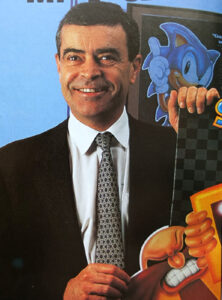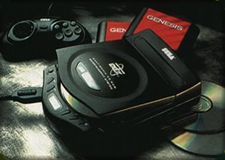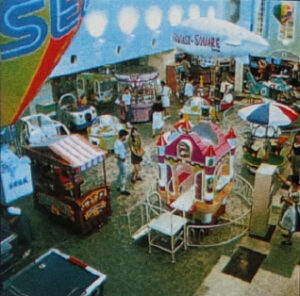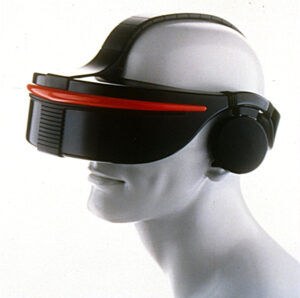This interview with Sega France’s General Director, Patrick Lavanant, originally appeared in the April 1994 issue of the French video game magazine Mega Force. In it, Lavanant discusses a variety of topics, including Sega’s multiple hardware platforms, the new 32-bit generation, the Sega Channel, and even Sega VR. It’s a fascinating look into one of Sega Europe’s biggest divisions and how it viewed the game market as the 16-bit generation entered its twilight.
 In authorized circles all around the planet, numerous rumors circulate, run, and fly… Often inaccurate, sometimes real, and occasionally absurd, these rumors make the world of video games a bubbling cauldron that never ceases to amaze professionals but can also be particularly annoying! Above all, Mega Force is an information magazine, not here to spread rumors but facts. To definitively put an end to the rumors, Mega Force deemed it necessary to visit Sega France and interview Mr. Patrick Lavanant, its General Manager.
In authorized circles all around the planet, numerous rumors circulate, run, and fly… Often inaccurate, sometimes real, and occasionally absurd, these rumors make the world of video games a bubbling cauldron that never ceases to amaze professionals but can also be particularly annoying! Above all, Mega Force is an information magazine, not here to spread rumors but facts. To definitively put an end to the rumors, Mega Force deemed it necessary to visit Sega France and interview Mr. Patrick Lavanant, its General Manager.
Mega Force: Mr. Lavanant, how do you assess the video game market today, and more specifically, the position Sega holds in France?
Patrick Lavanant: Today, I believe the market has reached maturity. Compared to 1992, the market has only decreased by 3.6% in sales volume. This is far from the often alarmist statements of some economists. However, it is true that in terms of value (money, if you prefer…), we’ve had a 20% decrease. This decline is mainly due to a drop in the prices of both machines and games and does not concern us at all. The market remains stable, and with the new products we intend to launch in the course of the year, both in hardware and software, we have full confidence. To give you an idea, in terms of sales, Sega sold 230,000 Game Gear and 350,000 Mega Drive units in 1993.
Mega Force: Compared to your main competitor, Nintendo, not to name names, what is your exact position?
Patrick Lavanant: Nintendo is a worthy and esteemed competitor. We have absolutely nothing against Nintendo. Being in the first position doesn’t really matter; it’s the games that count. The console is essentially a kind of VCR. What’s on the screen is what’s important, but to answer your question, Sega had, in the month of February 1994, a 57% market share compared to Nintendo. During the year-end holidays, this percentage was around 53 to 55%.
Mega Force: You mentioned new machines earlier. Can you tell us more about the surprises Sega has in store for us?
Mr Lavanant turns to Michael Barns, Sega’s Communications Director, who was also present at this interview)
Patrick Lavanant: Can I talk about it?
(Barns nods approvingly).
 Patrick Lavanant: We intend to release a cartridge by the end of the year that will transform the Mega Drive into a Super Mega Drive, running on 32 bits. This would position this machine far ahead of all its competitors, technologically speaking. This machine or cartridge could be called “Mars,” in reference to the “Saturn,” Sega’s 32-bit console expected to be available around mid-1995, but nothing is certain yet. Let’s simply say that “Mars” is only the project name and is not yet the final name of the machine. Apart from “Mars,” Sega also intends to release a new machine within a month that is fully compatible with the Sega CD and the Mega Drive: the Multi-Mega [Ed. note: known as the CDX in North America], which was first presented at the CES in Chicago. The Multi-Mega is a machine for purists and for an audience that appreciates new technologies.
Patrick Lavanant: We intend to release a cartridge by the end of the year that will transform the Mega Drive into a Super Mega Drive, running on 32 bits. This would position this machine far ahead of all its competitors, technologically speaking. This machine or cartridge could be called “Mars,” in reference to the “Saturn,” Sega’s 32-bit console expected to be available around mid-1995, but nothing is certain yet. Let’s simply say that “Mars” is only the project name and is not yet the final name of the machine. Apart from “Mars,” Sega also intends to release a new machine within a month that is fully compatible with the Sega CD and the Mega Drive: the Multi-Mega [Ed. note: known as the CDX in North America], which was first presented at the CES in Chicago. The Multi-Mega is a machine for purists and for an audience that appreciates new technologies.
Mega Force: Among all the new technologies and new media, do you see one in particular taking precedence over the others?
Patrick Lavanant: Currently, it’s still quite difficult to say. 1994, for sure, will be a 16-bit year. We will try to push our strong products to the maximum, such as Virtua Racing, for example, and games on Mega CD. Virtua Racing contains a new technology as the cartridge includes a DSP (Digital Signal Processor that enhances the computing capabilities of the Mega Drive, known at Sega as an SVP.
Regarding new media, an experience primarily orchestrated by Sega is being launched in the United States, in several regions, using cable technology. Each subscriber will be able, thanks to the cable used today to receive dozens of TV channels, to receive the game of their choice on their Mega Drive. In France, such an experience is still a bit premature, as the cable network currently interests only a few million households. However, it’s essential to know that this system, called the “Sega Channel” in the United States, can also operate through the broadcast network (Note: the broadcast network is used by the six traditional French channels). Significant opportunities are thus open in this field, and Sega is already at the forefront. I sincerely believe that, around the year 2000, the Sega Channel coupled with a 32-bit machine like the Saturn today will be one of the predominant media in the lives of “everyone.”
But honestly, if I knew the answer to this question 100%, I wouldn’t work at Sega anymore. I would simply be a billionaire! Sega is also very interested in the MPEG system, which appears to be the standard system for image compression and decompression (Note: MPEG allows, for example, the recording of 74 minutes of film on a CD).
Mega Force: New competitors are entering the console game, like Sony, 3DO, and Atari with the Jaguar. What do you think of them? Do they concern you? What are your weapons to compete?
Patrick Lavanant: The world of video game consoles is quite astonishing because, to my knowledge, there is no other field where only two companies are in direct competition. I first find it entirely normal that “others” are closely interested in it. It’s premature to say what I think at the current stage of things. The concept of the 3DO is interesting, but they haven’t found the right alliances. One thing is certain, we are moving towards these types of machines, but you can be sure that Sega will be present with a machine. The future, in my opinion, is not solely in the hands of a single manufacturer. For the Saturn, we have partnered with Hitachi, Microsoft, and other companies. Success can only come from “Joint Ventures.” Just like with the VCR in its time, if JVC hadn’t partnered with other manufacturers, VHS would never have exploded and become a standard as it is today. Sega has multiple strengths. We are leaders in the arcade domain, and we also intend to develop this sector in France. In England, three “Leisure Spaces” are already open, including one in Birmingham and one inside the largest toy store, Hamley’s.
Mega Force: Precisely. Speaking of arcades, Sega had announced the opening of such a Leisure Center in the heart of Paris, on the Champs-Elysées. What is the status exactly?
 Patrick Lavanant: This Center will indeed open its doors on the Champs-Elysées. However, it will not belong to Sega. We have only sold the license. Therefore, it’s not Sega France that will manage it. The individuals who purchased our license will simply have to respect the Sega image, and the Center will follow the specifications that we have determined.
Patrick Lavanant: This Center will indeed open its doors on the Champs-Elysées. However, it will not belong to Sega. We have only sold the license. Therefore, it’s not Sega France that will manage it. The individuals who purchased our license will simply have to respect the Sega image, and the Center will follow the specifications that we have determined.
Mega Force: Will this center be open to people under 18 years of age?
Patrick Lavanant: Yes, of course. A similar center already exists at Euro Disney, and it is open to everyone. The one at Champs-Élysées will be as well.
Mega Force: Last year, during CES in Chicago, Sega presented a virtual reality headset for the first time. We’ve heard nothing more about it since. What is its status, exactly?
Patrick Lavanant: We are behind on virtual reality. The system is not yet entirely ready. Today, we are far from the announcement we made in June of last year. Besides technical problems, there is still a more significant issue related to the dangers of virtual reality. Imagine wearing a headset, playing Sega VR, while a fire breaks out in your home… You won’t realize what’s happening until your feet are burning! This poses significant problems for us, more ethical than technical. Video games are a societal phenomenon, just as virtual reality will be in a few years. This phenomenon is inevitable.
Mega Force: Does virtual reality scare you?
Patrick Lavanant: Scare isn’t the right word. Virtual reality poses challenges for Sega and certainly for all other manufacturers. As for me, it doesn’t scare me because I have confidence in human nature. Not long ago, parents were alarmed to see their children captivated by television. Today, they are captivated by video games, and tomorrow it will be virtual reality. It’s inevitable. I repeat myself, but what is new has always been frightening and will continue to be. I still hear people talking about, when I was young, claiming that television caused cancer! It’s absurd. In my opinion, the educational role of parents is genuinely crucial. It’s essential to pay attention to your children and regulate their desires as much as possible, both for video games and for anything else.
Mega Force: Let’s get back to something more concrete and current. What do you intend to achieve in terms of games for us Europeans?
Patrick Lavanant: Currently, it’s true that games on the Sega Mega Drive are generally developed in the United States and Japan. Sega of Europe, based in London, has recently opened a Research & Development department to develop products closer to European culture. The first product developed by Sega of Europe was Astérix, a very European and especially French character. Sega is increasingly moving in this direction, adapting to each market based on culture, and providing a product that suits it better.
 Mega Force: Currently in the United States, as with movies, some cartridges are labeled with a logo specifying the age from which one can play a particular game. Are you considering such a “censorship” system in France?
Mega Force: Currently in the United States, as with movies, some cartridges are labeled with a logo specifying the age from which one can play a particular game. Are you considering such a “censorship” system in France?
Patrick Lavanant: It’s not censorship but a warning. Indeed, we are considering implementing such a system in France. Here, we don’t have a supervisory authority as in other countries. We will, therefore, take on the responsibility of informing Sega product buyers. Initially, we’ll send a message like, “This game contains scenes of violence that may be shocking, etc.” We don’t yet know exactly what we’ll implement. We don’t really know yet what we are going to put.
Secondly, we are considering adopting the same system as in the United States, including a minimum age.
Mega Force: Thank you.

Recent Comments